|
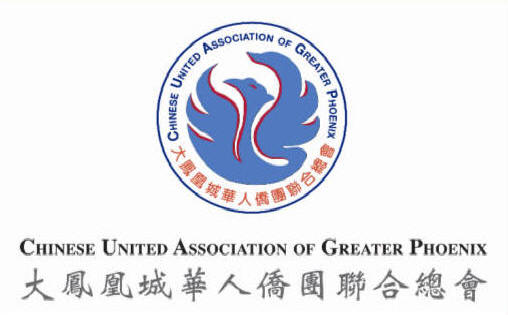
美國亞省華人百年歷史回顧
Achievements of
Chinese-Americans in Arizona History
Article
by Homer Zhang
1.Over a Hundred Years of Arizona
Chinese-American History
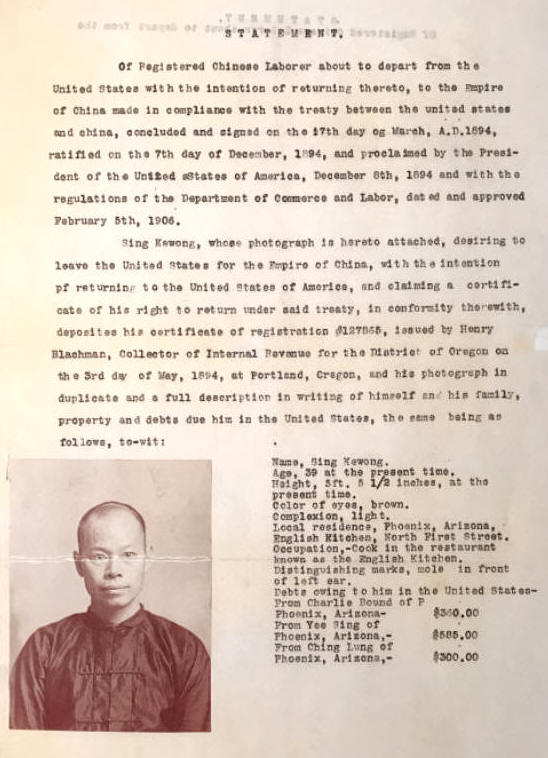 |
| The earliest
statements made by Arizona's
Chinese-American found. (1894) |
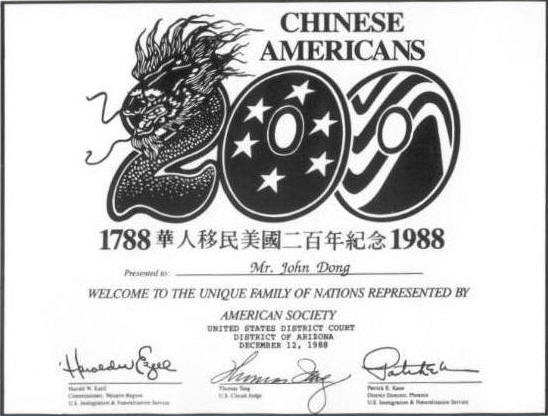
Bicentennial of
Chinese Immigration to U.S. (1788-1988)
The Chinese immigrants
came to the United States as early as 1788, twelve
years after the founding of the nation in 1776. It
can be said that the Chinese was one of the earliest
ethnic groups coming to the county. When the
“Bicentennial Chinese Immigration to America”
celebration was officially held in 1988 (the year of
the dragon), John Dong (鄧炳仗),
President of the Chinese United
Association of Greater Phoenix (CUAGP),
attended the commemorative event on behalf of the
local Chinese-Americans.
Chinese-Americans have been living in Arizona for
over a hundred years. In 1860, the Chinese began to
immigrate to Arizona and Mexico. In the same year,
or soon after, three Chinese started to grow
vegetables for a living in Tucson. The Chinese had
been selling vegetables door to door till 1897
according to historical record.
The early
Chinese settlers in Yuma area were the first
immigrants in Arizona, followed by those who later
entered Phoenix and Tucson area. In 1863, the
Caucasians established the Phoenix City Council. Two
years later the US military also set up post here.
The immigration of Chinese to Arizona was not
necessarily later than that of Europeans. During the
1860s, Chinese immigrants worked in the mines and as
servants, ran restaurants and laundries, managed
vegetable farms, and even performed menial labor at
the US military quarters. Chinatown began to
flourish during the 1870s. Competing with the White
Americans for business opportunities, the Chinese
had become the target of envy.
In the1880s,
the state railway project came to a completion.
While some Chinese went to work in the mines, the
majority of Chinese came to Phoenix Chinatown. They
contributed greatly to its development and
prosperity. In 1990, a number of Chinese relics of
early 19th century were excavated on the
construction site of the Phoenix Stadium in the city
center. The government immediately allocated a
budget of $ 50,000 for this archaeological
discovery. These relics provided sufficient evidence
indicating the Chinese had resided in Phoenix even
before the City Council was first established in
1863. They endured the toil and hardship, and also
shared the stability and prosperity of the city with
the Caucasians. In other words, the Chinese were
part of the Phoenix city and members of the society.
In the early
1890s, there were fewer than two hundred Chinese in
Phoenix Chinatown. The state upheld legislation that
discriminated against residents with Chinese
ethnicity. In 1892, the anti-Chinese movement began
to escalate among the locals, and the media went
along. In the same year, Congress passed the Geary
Act, prohibiting Chinese residents from becoming US
citizens. The Chinatown began to decline since then.
By the early
20th century, the local Chinatown began to flourish
again. In the early 1910s, the three major hotels of
Chinese, British and French style in Phoenix
Chinatown were all owned by the Chinese. Before the
1930s, there were approximately three hundred
Chinese residents in Chinatown. The Chinatown then
was located between the 1st Street and 3rd Street,
bordering Madison and Jefferson. It was and still is
today, the central and downtown area of the city
of Phoenix.
The Yu Family
has over a century history in Phoenix. In the early
20th century, Sing Yee ( Yu Kang ) of the Yee Clan
ran the American Kitchen, located on Central Street
in downtown Phoenix. It was one of the few Chinese
restaurants at that time . Fluent in both Chinese
and English, Mr. Yee managed the restaurant well,
maintained good relations with the local government
and businesses, and helped folks who just arrived in
Chinatown.
According
local official records, the number of Chinese in
Chinatown was 101 and 448 in 1950. The population
increased only by 357 people in a seventy year span.
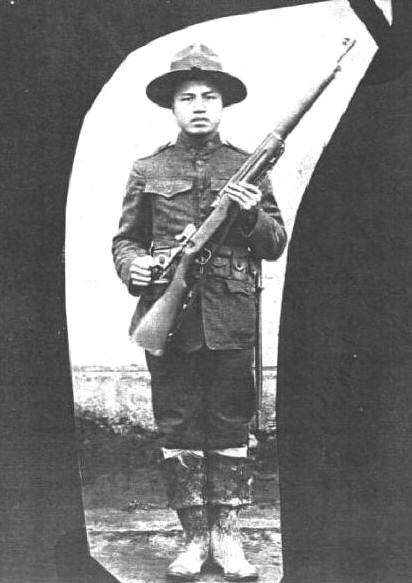 |
|
Dea Hong Toy (關崇瓊)
in the World War I.
(1915) |
| |
|
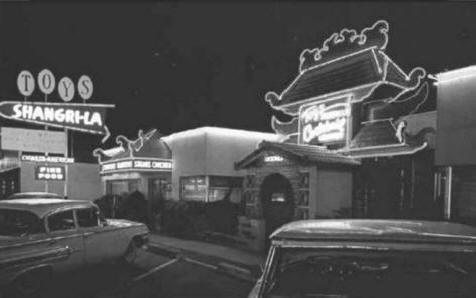
TOYS "SHANGRI-LA" restaurant (1950)
In 1939, seven Chinese in Phoenix, Deng Kailong (鄧楷隆), Wing F. Ong (鄧悅寧), Deng Xielong (鄧協隆), Deng Yisheng(鄧以笙), Deng Juezhang (鄧抉章), Deng Tongyan (鄧同衍), and Yu Qingzong (余慶宗), registered and founded the first local Chinese organization, "the Chinese Chamber of Commerce". Wing F. Ong (鄧悅寧) served as its first President.
The Chamber of Commerce organized activities to celebrate the 4th of July Independence Day. For a long time, the Chinese Chamber of Commerce has maintained good relationship with the state and city government. Working with government agencies, it helped Chinese business owners with issues such as sanitation and safety. Designated by the Arizona Immigration Services, it also administered the naturalization test for Arizona Chinese immigrants.
In the 1970s, there were about 5,000 Chinese in Chinatown. Since the 1980s, the family based immigration had increased tremendously due to the establishment of the Sino-US diplomatic relations. From the 1990s till present, the total number of overseas Chinese population in Arizona has reached to nearly 100,000 with the influx of businessmen and students as well as the Chinese immigrants from Southeast Asian countries. Phoenix has emerged from a border city in the west to a well-known cosmopolitan.
Nevertheless, the Chinese will not forget their history. At the beginning of 1990, as many Chinatown relics were excavated in downtown Phoenix, the Phoenix Chinese Chamber of Commerce launched the "Phoenix Chinatown Culture and Heritage Exhibition" campaign. With strong support from the local Chinese, the campaign raised nearly $ 20,000. Combining the subsidies from the city government, the total reached over $ 52,000 dollars for the first Phoenix Chinese history exhibition.
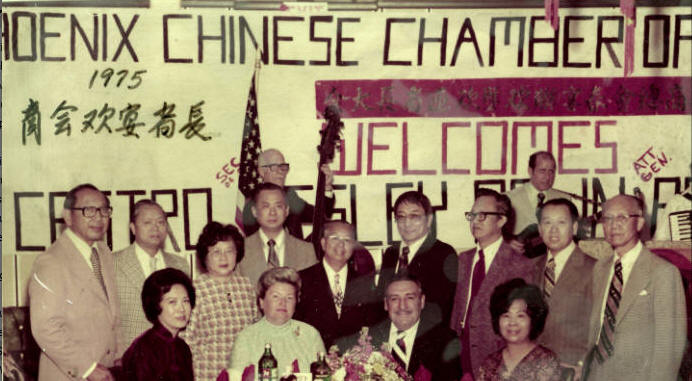
Chinese Chamber of Commerce maintained a
good relationship with State Government and
municipal departments (1975).
|
2.Contributions of
Chinese Americans in Arizona
|
|
Chinese Americans joining the army and defending the
count |
Over the years, Chinese-Americans in Arizona have
joined the military risking their lives for the
country. Among them, six were died but information
could be found only for the three who served in the
Air Force in the World War II.
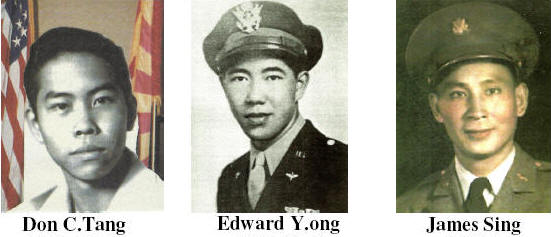
Two Chinese-Americans, Hong Ham and Dea H.
Toy (關祟瓊),
joined the army during the World War I. Recruited in
1915, Dea was sent to Europe in 1917 and received
his Purple Heart Medal for his battle wounds in
France. Dea’s son William K. Toy (關衛理)
also joined the army. He had trained Chinese
soldiers in China and fought against the Japanese
army in northern Burma. Gary Toy, Dea’s another
son, joined US Air force and was appointed Sergeant.
The two brothers received many military decorations
for their service. William K. Toy stayed in the
army for over twenty years, and was promoted
lieutenant colonel. William held the highest
military rank among all the Chinese -American
soldiers from Arizona. William also served as an
instructor in a military academy in Arizona.
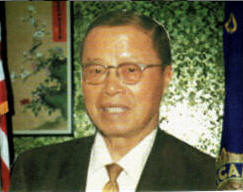 Dea H. Toy
Dea H. Toy |
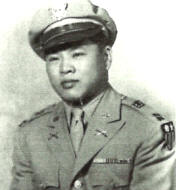
William K. Toy |
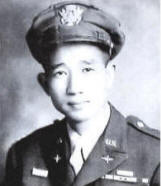
Hong j. "Albert " Ong |
During
World War II, seventy nine Chinese-Americans joined
the army, the Navy, the Air Force, and fought
fearlessly against the enemies. Four of them were in
the Chinese- US Fourteenth Air Force Flying Tigers
Mixed Brigade. Hong j. "Albert "Ong
(鄧桐臻)
joined the US Air force in 1941, and was the Combat
Staff Officer in the Fourteenth Air Force Flying
Tigers. He was deployed to Kunming, Guiling,
Chengdu and other places in China. Ong received an
Anti-Japanese War Memorial Medal, an Order of
Precious Tripod Medal among other decorations after
the war. Five Chinese-American soldiers
sacrificed their lives in World War II. Three of
them served in the air force. The photo below
was the four Ong brothers.
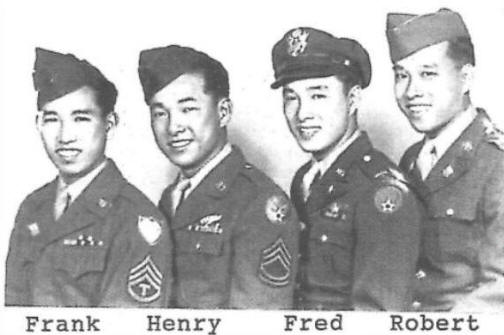
When the Korean
War broke out in 1950, twenty- three
Chinese-Americans from Arizona joined the military.
Twenty two Chinese-Americans fought in the Vietnam
War from 1961-1972. A few of them provided
clerical and technical supports, and one was a
female officer working behind the communication
terminals. Arizona Chinese-Americans also fought in
the following Middle East and Afghanistan Wars.
In 1950, forty-four veterans came together to form a
Chinese-American veterans organization. It was
later renamed “Deng Xinping (鄧心平)
Veterans Association (American Legion Thomas Tang
Post 50)”. Three white veterans also joined it. It
has become a well-known Chinese-American Veterans
organization.
Successful Chinese-American
Politicians
In
1940, Wing F. Ong (鄧粵寧),
a Chinese-American lawyer, run for the State House
of Representatives of Arizona for the first time and
lost by 17 votes. In 1946, 42- year- old Wing F.
Ong decided to run again. His campaign slogan, “Give
the person who knows the law a chance to participate
in politics,” won him the votes from Americans and
Hispanics/Latinos, Chinese and other Asian
immigrants. He won his campaign and
became the first Chinese-American State House
Representative who was not born in the United
States. Mr. Ong was reelected and served a second
term. In 1966, Mr. Ong ran for the Arizona State
Senate and succeeded, becoming the first
Chinese-American who entered the State Legislature.
Wing F. Ong (鄧粵寧)
Arizona Chinese-American, Wing F. Ong’s earliest
election campaign poster in the 1940’s has great
historical value.
Born in Phoenix, Arizona, Judge Thomas Tang (鄧心平)
graduated from the University of Santa Clara with a
B.S. He served in the army during the World War II
and the Korean War. After Korean War, he studied
law and graduated from the College of Law,
University of Arizona. He was elected to the
Phoenix City Council and later the deputy mayor.
In 1977, President Jimmy Carter appointed Tang as
the United States Circuit Judge for the Ninth
Circuit covering ten states including Washington,
California, Arizona, and Nevada. His
achievement at the judicial branch has never been
surpassed by any other Chinese-American.
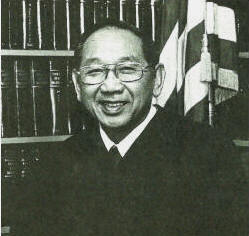
Judge Thomas Tang
Among the city mayors in
the United States, three of them are
Chinese-Americans from Arizona.
In 1979, Edmund Tang (鄧達明)
was elected as the mayor of Peoria. Edmund Tang had
to work very hard to win the elections, as there
were then only two Chinese-American families in the
city, and the majority of the voters were Caucasian
and Hispanic/Latinos. He succeeded and served three
consecutive terms. Edmund received the
honorary title, the Mayor
Emeritus of Peoria for his 30 years’ service from
1955-1985. He is an outstanding role model for the
Chinese-American politicians.
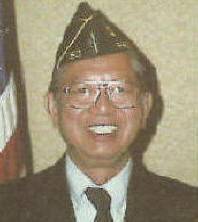
Edmund Tang
(鄧達明)
The
next one to be mentioned is Willie Wong (鄧偉利),
Mayor of Mesa, Arizona. Willie Wong graduated from
Arizona State University. He had worked at
AT&T for over twenty years. He held various titles
and positions such as chairman of Mesa YMCA,
President of City Council of the City of Mesa,
President of Maricopa Association of Governments,
Deputy Mayor of Mesa from 1988-89, and was elected
Mayor of Mesa in 1993. At that time, the City
of Mesa became the most populous American city
administered by a Chinese-American mayor.
Given the fact that the Asian population in the city
of Mesa at his time accounted for only 1%, the
success of his political career was even more
extraordinary. During his tenure, Wong led the
Sister Cities Commission of Mesa to China and
established the sister city relationships with
Kaiping (開平市),
China.
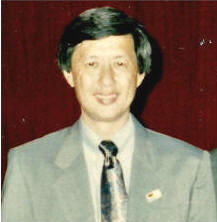
Willie Wong (鄧偉利)
The third one is Dingqi Deng (鄧鼎奇).
Dingqi Deng was elected as the Mayor of Superior
City, Arizona in 2009. Dingqi’s grandfather
managed a grocery store in his early years. A local
street was named after him for his contributions to
the community. Dingqi was born in the US. He
studied Agricultural Science at college, but became
a successful businessman. He won his mayoral
election after entering politics.
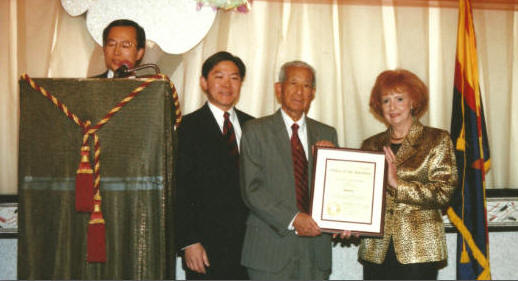
Hong J. “Albert” Ong (鄧桐臻)
received his Bachelor of Business Administration
from Northern Arizona University in 1952, and later
served as a member of Holbrook City Council. After
moving to Phoenix in 1978, he started to participate
in the construction of the Chinese Senior Center.
Well versed in both Chinese and Western learning,
Mr. Ong collaborated closely with the city
government on the project. After three years of
continuous effort, the construction of the first
Chinese Senior Center was completed in 1981.
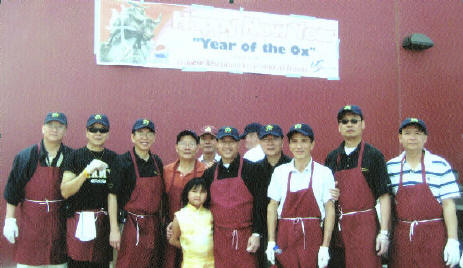
Barry Ong (黃仕鈞)
University with a degree in mathematics, he went to
law school at University of Arizona in Tucson. He
got his license and practiced law afterwards. He
started to work in the State Senate assisting in
parliamentary legislation in 1993 and became a
member of Arizona House of Representatives the same
year. Mr. Wong is the second Chinese-American who
has entered the state legislature in Arizona
history. He was elected again a year later, and made
great contributions during his eight-year tenure.

Kimberly Yee (余艷芬)
received her Master of Public Administration from
Arizona State University. She was the office manager
of Communication and Government Affairs for the
Office of Arizona Treasurer. Elected to the State
House in 2010, Ms. Yee became the first
congresswoman of Chinese ethnicity in Arizona 100
years of history.
In 2016 she became a spokesperson for
the Arizona senate majority leader. In 2018 she was
elected as the Arizona state treasurer.

John M. Yee
(余文勁),
who is recognized by the mainstream society as a
senior
and well respected Chinese
community leader, has served the Chinese community
throughout his life, and was received “Service
Overseas Chinese
Lifetime Achievement
Award”
in 2011.
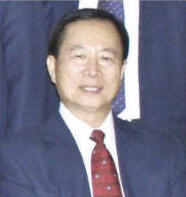
Gray Ong (鄧朝駒)
was appointed by President Bush as a member of
President’s Advisory Commission on Asian Americans
and Pacific Islanders. He attended the Hong Kong and
Macao Handover Ceremonies on behalf of Arizona
Chinese-American communities.
3.Activities and Significant Events
of the Chinese-American Community
celebrating Independence Day
Chinese-Americans in Greater Phoenix have
been celebrating Independence Day in many locations
in Phoenix since 1937. In 1970, CUAGP began to host
the festivity. For over 70 years, Chinese-Americans
have sought for recognition and fought against
prejudices. Chinese culture has also been promoted
through these events. The annual celebrations have
caught the attention of mainstream society and won
their support. Governor Bruce E. Babbitt attended
the celebration in 1979. Over the years, many local
luminaires appeared at the celebrations and the Miss
Phoenix Chinese Pageant events.
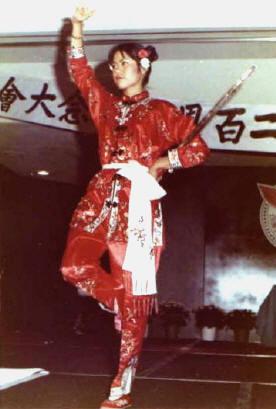
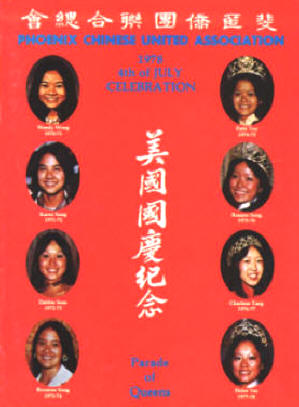
|
U.S. Bicentennial Celebration (1976) |
CUAGP’s The first U.S Celebration book
(1978) |
| |
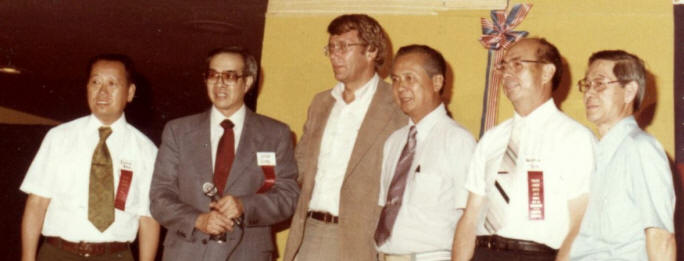
Governor Bruce E. Babbitt at the Celebration (1978)
Phoenix Mayor Skip Rimsza
once sent his congratulatory message, “I would like
to welcome everyone who is here to celebrate the
Independence Day with the Chinese American
community. You have been celebrating this historical
day since the late 1930s. Starting with the flag
raising ceremony by American Legion Thomas Tang Post
50, as usual, it includes such fun activities as
pageantry, ethnic dances and food. I would like to
thank everyone for coming and wish you all a safe
amazing day.” Governor Jane Dee Hull also sent her
congratulations, “On behalf of the State of Arizona,
I would like to extend a warm welcome to those
attending the Chinese United Association of Greater
Phoenix’s 4th of July Celebration. 4th of July is a
time for celebration and reflection for our nation
and I am pleased to honor and recognize this year’s
festivity. Thank you for your active involvement and
valuable contribution to the Chinese community. I
commend you for your commitment and dedication to
the citizens of Arizona. You have done a wonderful
job to keep the community spirit strong.”
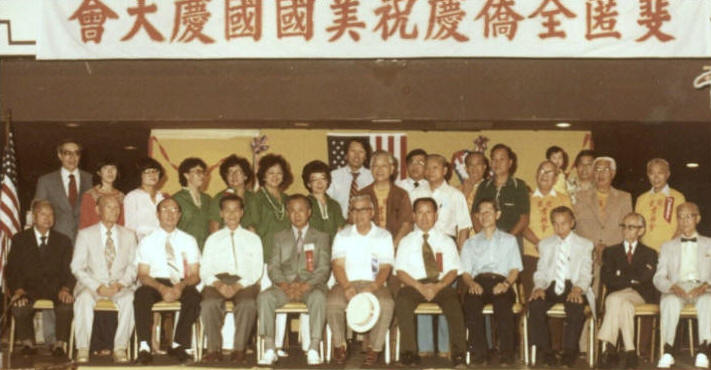
Chinese-Americans have been celebrating Independence
Day for 80 years.
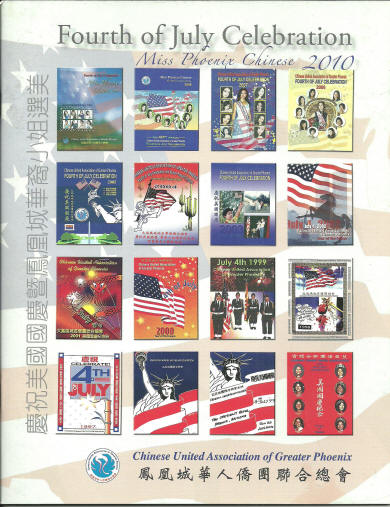

CUAGP’s 50 years of hosting Independence
Day Celebration and Miss Phoenix Chinese
Pageant
Maintaining Communication with Mainstream Society
and Promoting Harmony within the Community
From 1970s to 2000s, Great Wall and Hua Mei
were the two biggest and most successful Chinese
restaurants. They were also the venues for hosting
interactive events between mainstream society and
the local Chinese-American community. CUAGP has
hosted many fundraising dinners for candidates who
run for governor and mayor, and for the House and
Senate. Local Chinese and the mainstream have
maintained a good relationship through these
activities. CUAGP has been a positive force since
its founding. For over 50 years, CUAGP strives to
keep the community united and stable. A harmonized
and progressive Chinese community is also one
indispensable factor to maintain the stability and
prosperity of the big Arizona multi-ethnic family.
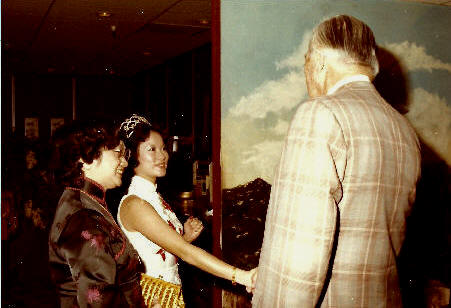
Politicians attended the fundraising
dinner at the Great Wall restaurant
(1977)
 Chinese-American community
maintains a good
relationship with the
mainstream society.
Chinese-American community
maintains a good
relationship with the
mainstream society.
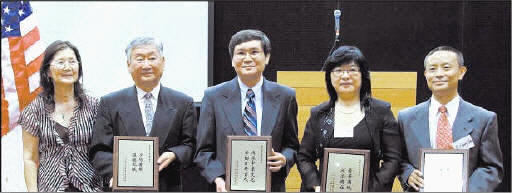
Chinese-Americans
have made great
accomplishments
in various
areas.
With
regard to
education, the
Chinese
linguistic
schools and
student
enrolment have
continuously
been increasing
since 1980. In
addition, the
constructions of
the Senior
Center and the
two apartments
for elderly
allowed elderly
Chinese-Americans
enjoy their
remaining years.
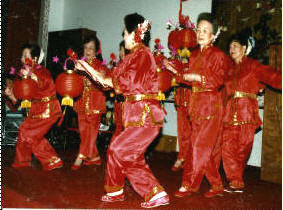 |
|
Chinese-American
Seniors
Enjoying
Their
Happy
lives. |
The Chinese Week
The Chinese Week, founded by CUAGP in 1991, has broad and profound impact on mainstream society in Arizona. The event held in Phoenix Chinatown attracts nearly 200,000 people with various ethnicities annually. Chinese culture and the ancient oriental civilization are introduced during the week. Each year, the Chinese Week features performances by artists from sister cities of Chengdu and Taipei, by the students from Chinese linguistic schools and the Chinese-American associations. Chinese cuisines, folk arts and crafts, and customs and traditions arouse local people’s interests in learning Chinese culture.
As a result, we see American children performing Chinese dances and African-Americans playing Chinese Gong Fu. Chinese has become one of the foreign language classes offered at schools, and Confucius Institutes were established in state universities. We see people bustling to Chinatown to visit Chinese gardens, to enjoy Chinese folk arts, and to buy Chinese products. The Americans with children adopted from China come to Chinatown to look for Chinese culture. Over the years, the function of Chinatown has extended far beyond that of business operation and taxation. Likewise, the Chinese Week has become a platform for fostering friendship between China and America, and a window to exhibit the Chinese culture.
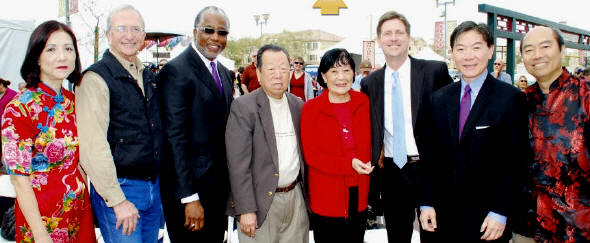
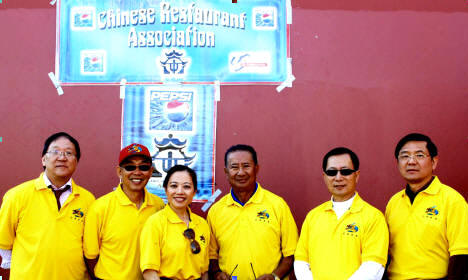
Chinese Restaurant Association of Arizona (CRAA) provides meals for hundreds of homeless.
4.The Chinese-American community caught more attention and received assistance from the government.
The Chinese-Americans have caught attentions and received assistances from the government for years, due to their own efforts, and their achievements in public service from which they have also gained valuable experience. When applying for funding to build Kong Ning House Apartment, they received over $1,300,000 from the government. They also got financial assistance from the government for the expansion of the senior center. In 2008, the government funding even reached a whopping 5.4 million dollars, when CUAGP and Phoenix Chinese Senior Citizen Association (PCSCA) applied for the construction of the Kong Lok Senior Housing Center. Now, the construction of the Kong Lok Senior Housing Center was completed and put to use.

|
|
Receiving over 1.3 million federal government funding for the construction of the Kong Lok Senior Housing Center, Wenyu Yee couple and John Yee couple met with Congressman Bob Stump. |
|
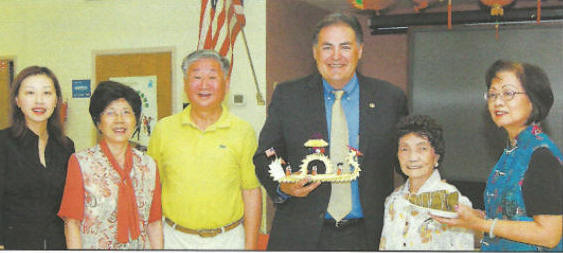
The PCSCA
often receives commendations from the government for their accomplishments.
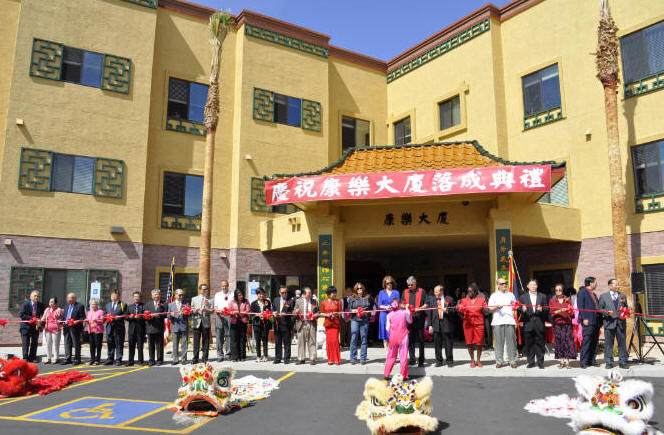
The completion of the Kong Lok Senior Housing Center in 2011.
In the 1970s, the local Chinese-Americans launched the first charity event and raised $150,000 for the construction of the Chinese-American Senior Center. In the 1980s, they donated money to build the Chinese Linguistic School. In the 1990s, John Yee and other leaders of the Chinese-American community once launched a fundraising event and raised nearly $300,000 dollars for the expansion of the Chinese-American Senior Center. That event has collected the most donations in Arizona Chinese-American history. Over the years, the local Chinese-Americans had actively and generously contributed donations to disaster relief such as the flood in southeast China and the 9/11 attack. They also donated money to help build Beijing National Aquatics Center. After the 2008 earthquake in Sichuan, China, Chinese-Americans, together with the mainstream society, held fundraising activities and donated over $250,000 to the disaster area.
Regarding the welfare and charity within the state, Arizona Chinese-Americans are unwilling to fall behind. Arizona Chinese-American charitable organizations have long helped numerous people in need. Likewise, the Chinese Restaurant Association of Arizona (CRAA) has provided meals on the New Year’s eve for hundreds of homeless over the years.
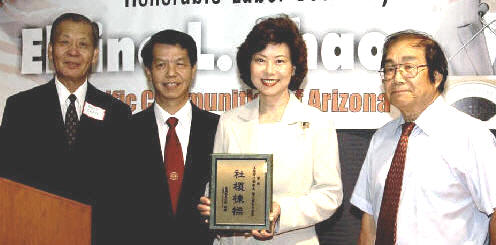
Lung Kong Tin Yee Association presented an award plaque to Secretary of Labor, Elaine Chao in 2008. |
In 2008, Secretary of Labor, Elaine Chao visited the Chinese-American community in Arizona and received a warm welcome. The Arizona Governor Jan Brewer attached great importance to the relations with China. She visited Beijing in 2011, and expected to cooperate with China in renewable energy. Currently, 5,400 enterprises in Arizona have business relations with China. The Governor also pays a lot of attentions to the local Chinese-Americans, and commends them for their contributions to the big Arizona multi-ethnic family. In April 2011, she signed the first Act about the protection of women proposed by Kimberly Yee, the Chinese-American State Representative. She sent congratulatory letters to the Chinese Americans when they celebrated the American National Day.
Governor Jan Brewer welcomed Bangguo Wu (吳邦國), Chairman of the Standing Committee of the National People’s Congress of PRC.
(2009)
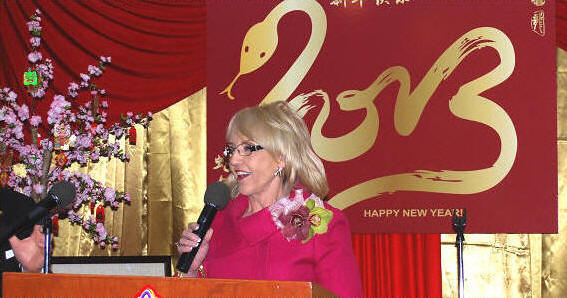
On Jan. 31st,
2013, Governor Jan Brewer received a warm welcome
when she attended the CUAGP’s New Year Festive
Banquet and delivered speech. The Arizona
Chinese-American community also supports the
Governor, and appreciates the attentions received
from the state and municipal governments.
A final note: he is no longer
an alien in this foreign land, as it has become his
homeland over time. As we celebrated the Centennial
of Arizona, the Chinese-Americans reflected on their
own history in the state -- from pioneering
hardships to the opening-up of a new prospect and
from being discriminated against to being respected.
Chinese immigrants have come a long way in the past
morn100 years. Through perseverance and hard work,
Chinese-Americans have made outstanding achievements
in politics, military and other professions.
Chinese-American community associations have also
made a great impact. Looking ahead, the
Chinese-Americans in Arizona will continue striving
for excellence and pursuing greater success.
(Homer Zhang Written history
of Achievements of Chinese- Americans in Arizona
History Is included in collection , by the US
Library of Congress and major cities and university
library collection; Homer Zhang won the special
award.)
|